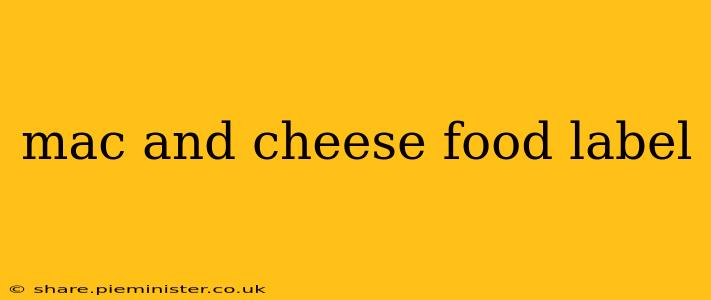Decoding the Mac and Cheese Food Label: A Guide to Understanding What You're Eating
Mac and cheese. The ultimate comfort food. But have you ever really looked at the nutrition label on your favorite box? Knowing what's in your mac and cheese can help you make informed choices about your diet and health. This guide will walk you through the key components of a mac and cheese food label, helping you decipher the ingredients and nutritional information.
What are the main ingredients in most mac and cheese?
Most boxed mac and cheese varieties contain a blend of pasta (usually elbow macaroni), cheese powder (a combination of cheeses and other ingredients), and sometimes other flavor enhancers. The specific cheeses used vary greatly between brands, but common choices include cheddar, parmesan, and processed cheeses. The cheese powder often contains ingredients like modified food starch, salt, and various emulsifiers and stabilizers to create the creamy texture we love. Some brands also add butter powder, coloring agents, and preservatives.
What does the "Nutrition Facts" panel tell me?
The "Nutrition Facts" panel is crucial for understanding the nutritional content of your mac and cheese. It lists:
-
Serving Size: This indicates the amount of mac and cheese you're considering in the nutritional analysis. Be mindful of this; a single serving might be less than you typically eat.
-
Calories: This reflects the energy content of a single serving. Pay attention to this, particularly if you're watching your calorie intake.
-
Total Fat, Saturated Fat, Trans Fat: Fat content contributes to calories and has implications for cholesterol levels. Saturated and trans fats should be consumed in moderation.
-
Cholesterol: Mostly from the dairy ingredients. High cholesterol levels can be a health concern.
-
Sodium: Mac and cheese is often high in sodium, so consider this if you're watching your salt intake. High sodium intake is linked to several health problems.
-
Total Carbohydrate, Dietary Fiber, Total Sugars: Carbohydrates are the main source of energy. Dietary fiber is important for digestive health. Added sugars contribute extra calories and can impact blood sugar levels.
-
Protein: Protein is essential for building and repairing tissues.
-
Vitamin D, Calcium, Iron, Potassium: These are essential nutrients, and the label indicates their content in a serving of mac and cheese.
What are the common additives and preservatives in mac and cheese?
Many processed mac and cheese products contain various additives and preservatives to enhance flavor, texture, and shelf life. These can include:
-
Modified food starch: Used as a thickener.
-
Emulsifiers: Help to blend the ingredients smoothly.
-
Preservatives: Prevent spoilage and extend shelf life.
-
Artificial colors and flavors: Enhance the appearance and taste of the product. Always check for indications of artificial ingredients if you're trying to avoid them.
-
Natural flavors: While sounding healthier, these can still be complex mixes of ingredients.
How can I find healthier options of mac and cheese?
While classic boxed mac and cheese often contains significant amounts of sodium, fat, and processed ingredients, there are healthier options. Look for:
-
Lower sodium options: Some brands offer reduced-sodium versions.
-
Whole wheat pasta: Opt for whole wheat pasta instead of refined pasta for added fiber.
-
Homemade mac and cheese: Making your own mac and cheese allows you to control the ingredients, ensuring you use fresh, higher-quality cheese and avoid excessive salt and additives.
-
Brands focusing on "clean" ingredients: Some brands highlight using simple, natural ingredients, which is always a good sign.
Does the label tell me about allergens?
Yes! Food labels are legally required to clearly state any potential allergens present in the product. Common allergens include milk, eggs, soy, wheat, peanuts, tree nuts, fish, and shellfish. Always carefully check the label if you have any allergies.
By carefully examining the mac and cheese food label, you can make more informed choices about what you're consuming, contributing to a healthier and more conscious eating experience. Remember that reading the label is only part of the equation; understanding what those ingredients mean and how they contribute to your overall diet is key.
